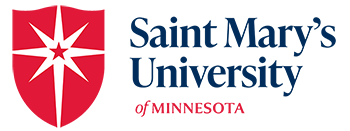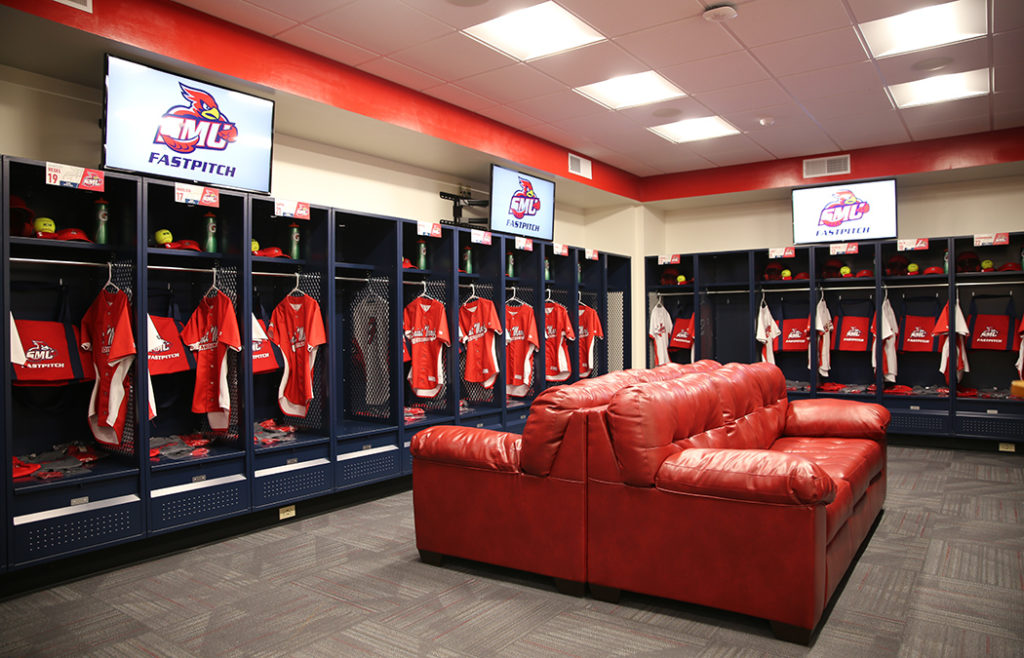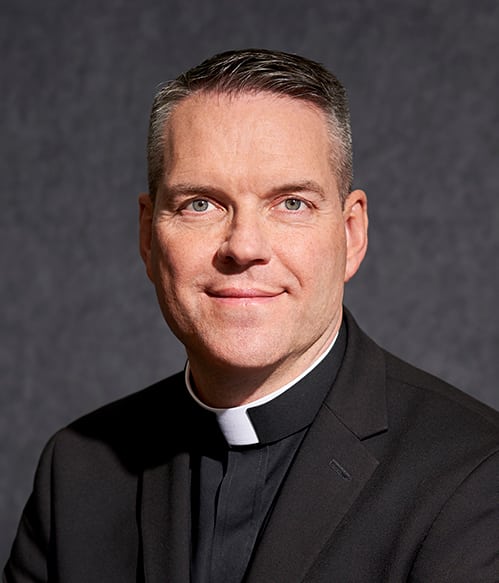Saint Mary's Newsroom
Campus ConnectionAn update from the president to alumni and parents
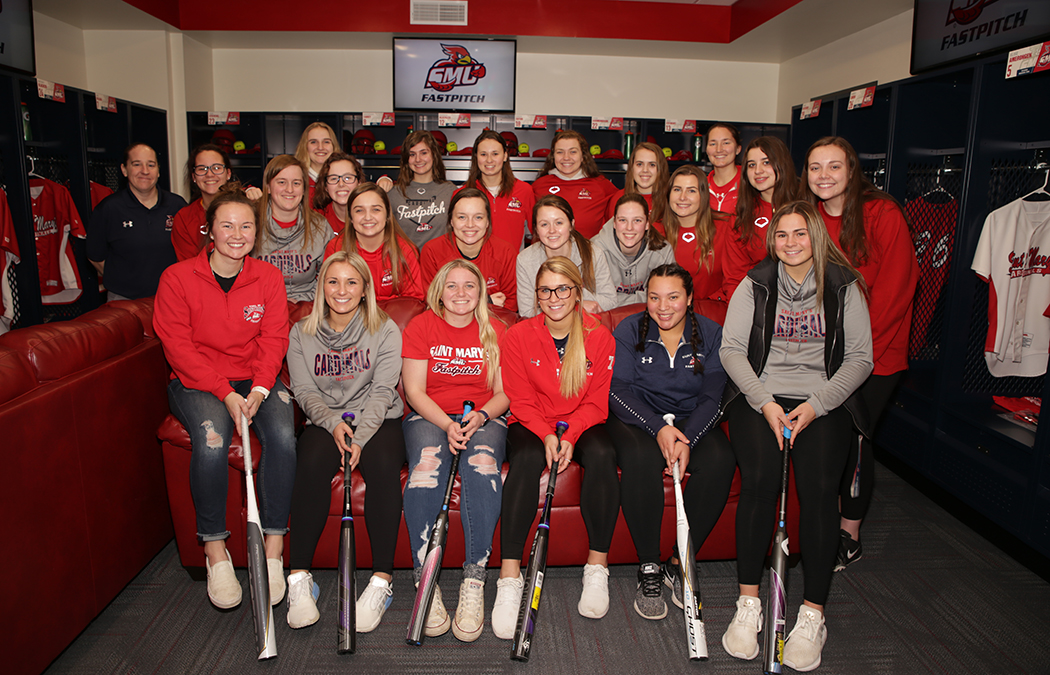
Saint Mary’s completes new women’s softball locker room facility
It was a home run in a doubleheader. Saint Mary’s University athletics unveiled and blessed a new locker room facility for Cardinal women’s fastpitch softball Monday, Jan. 20 — one year after unveiling its new clubhouse for men’s baseball.
“We know that key components of a winning team are spirit, strength, skills, teamwork, character, and the right facilities and tools,” said Tim Gossen, vice president for Student Affairs and Student Life. “This new space is just one example of how Saint Mary’s is dedicated to helping our student-athletes succeed.”
The new 1,200 square-foot space, located beneath the Saint Mary’s gymnasium, includes 29 lockers, a separate study and lounge space and team meeting space, and several large screen TVs. Additionally, private showers and bathroom facilities were constructed.
Brian Sisson, Saint Mary’s athletic director, said that all Cardinal athletic teams now have their own year-round space to call home.
“This facility is one of the spaces where we develop today’s student leaders and tomorrow’s community, business, and organizational leaders,” Sisson told the athletes at the unveiling. “We hope you use this as a space to grow — as a team, and as an individual.”
Saint Mary’s women’s fastpitch softball has played a large and continuous role in Cardinal history; 20 years ago this spring the women’s softball team brought home the national championship.
Audrey Kintzi, vice president for Advancement and Communication, thanked the benefactors who have so far stepped up to the plate to support the addition of the new facility. Six of the 29 lockers have already been sponsored.
“Our alumni tell us their time as athletes here was transformational. Here is where they made lifelong friends, where memories on the field were made, and where they learned how to time manage. Here is where they learned to both lead and be led, both of which are very valuable skills that you’ll need throughout your lifetime. It’s because of these deep and heartfelt memories that our alumni give back; they want you all to have those same experiences … and some even better ones.”
To sponsor a locker, or support women’s softball, contact Kintzi at akintzi@smumn.edu or 507-457-1486.
See more photos from the event.
Saint Mary’s Taylor Richmond Benefit to help two recipients in honor of 20th anniversary
Saint Mary’s University’s Taylor Richmond Benefit Dance, celebrating its 20th year of helping those in need, is scheduled for 8 p.m. to midnight Saturday, March 14.
For the first time, two beneficiaries will split the proceeds from this year’s event: Gianna Samountry, the younger sister of Saint Mary’s student Logan Samountry, of Richfield, Minn.; and Winonan Sue Schroetke, who has worked in the university’s Maintenance Department for the past nine years.
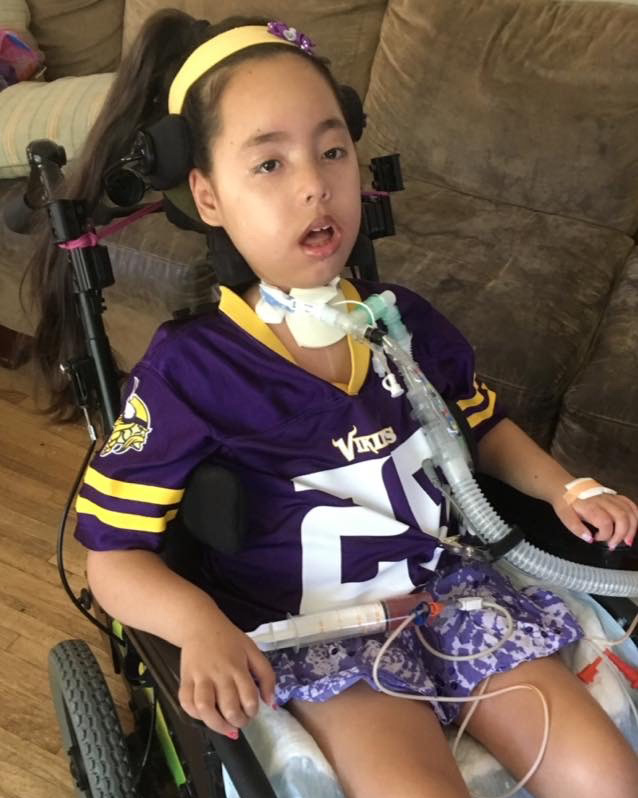
Gianna Samountry
Samountry, now 11, was treated with chemotherapy for neuroblastoma when she was eight months old and developed a rare autoimmune disorder called paraneoplastic syndrome. As she is paralyzed, on a ventilator, fed through a tube, and has a seizure disorder, she requires 24-hour nursing care. Samountry also has special transportation needs, and the family hopes to use their portion of the proceeds to purchase a handicapped accessible van to take her places she has never previously been able to visit.
Schroetke has battled liver disease for the past 20 years. Although last winter she received a successful transplant, she is hoping to use funding from the benefit to help her with ongoing and mounting medical bills. She also could use a dependable vehicle for her many trips to Mayo Clinic in Rochester, and help to repair the leaking roof of her home.

Sue Schroetke
The theme of the evening will be “Igniting Hope for 20 Years.” The Hall of Fame Room in the Toner Student Center will be decorated, complete with a photo booth, and refreshments will be served.
The dance, featuring music by the Johnny Holm Band, will be held in the gymnasium. Ticket prices are $15 for students, $20 for faculty and staff, and $25 for the general public and are available at smumn.universitytickets.com. Dance tickets will also be available at the door.
A silent auction will be held on campus from 9 a.m. to 3:30 p.m. Thursday and Friday, March 12-13. A variety of homemade goods, gift baskets, and specialty items will be on display in the Common Room, located on the third floor of Saint Mary’s Hall. The public is welcome to bid. Donations are needed.
The benefit has become an annual student tradition since its start in 2001 in honor of Taylor Richmond, son of former Saint Mary’s staff member Nikki Richmond. Each year, this event benefits someone in need who has ties to the university community.
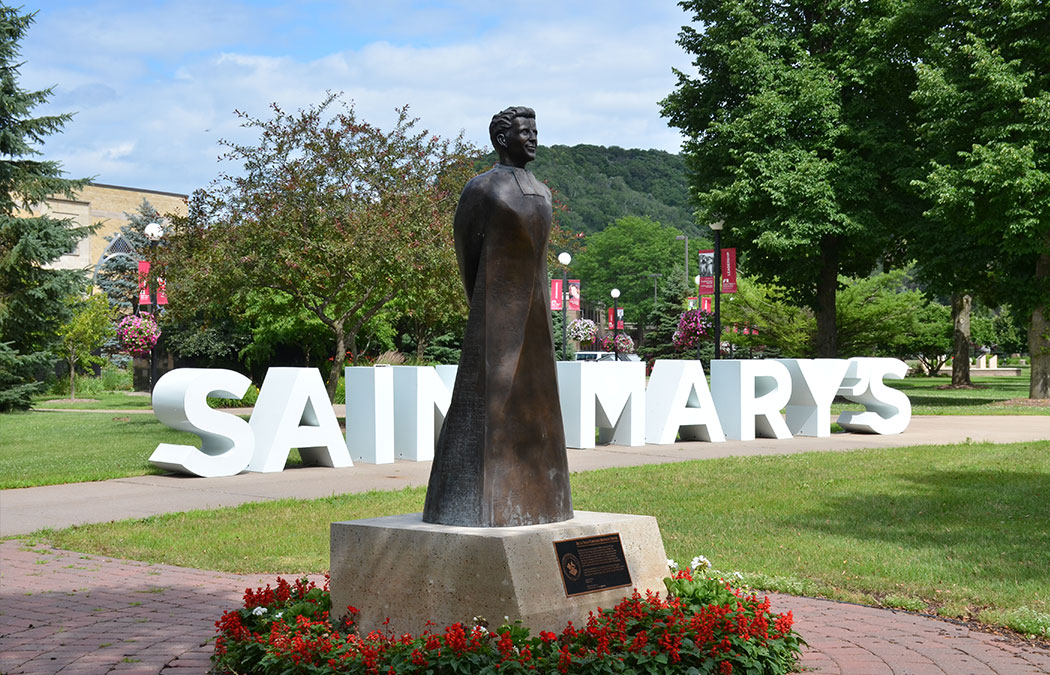
Study shows ROI of liberal arts colleges is comparable to career-focused schools
What is the value of a liberal arts education?
This question has been asked for years within circles of higher education — especially in light of an uptick in students seeking undergraduate degrees with a seemingly straight path to the job market.
Such trends have put liberal arts colleges under siege, forcing several institutions to slash or reduce programs in traditional fields and replace them with more direct job-focused majors.
According to a newly published report from Georgetown University Center on Education and the Workforce, though, the median return on investment (ROI) 40 years after enrollment from liberal arts colleges is comparable to that at four-year engineering and technology-related schools, as well as business and management schools.
The median ROI from liberal arts colleges is $918,000, more than 25% above the median ROI of all colleges and universities, which is $723,000. The median at engineering or technology schools is $917,000; business and management schools is $913,000.
For the purposes of the report, the ROI was directly determined by a dollar figure known as net present value (NPV), which was calculated through a methodology that the center developed in a previous study of ROI at more than 4,500 colleges.
The ROI at liberal arts colleges is the third highest among the 14 different types of four-year institutions, as defined by the Carnegie Classification of Institutions of Higher Learning.
Furthermore, the study found that ROI is higher for liberal arts colleges that have a high share of STEM majors (science, technology, engineering, and mathematics). Liberal arts institutions in the top third, in terms of the share of students who have STEM majors, have a 40-year ROI of $992,000. To compare, this is $179,000 more than colleges in the bottom third.

Doctoral counseling psychology student explores Hmong roots, creates large regional following with videos
‘This is something I have struggled with my whole life’
Before the keynote speaking engagements, the social media following, and the website, there was a video filmed on the cell phone of Calvin Yang M’17.
In August 2017, he had just finished one of his first classes on the Twin Cities Campus and was en route to his Doctorate in Psychology of Counseling Psychology.
The class centered on integrating culture into therapy to make it more sensitive to those intricacies, given that most of the commonly accepted therapeutic interventions were developed by white psychologists.
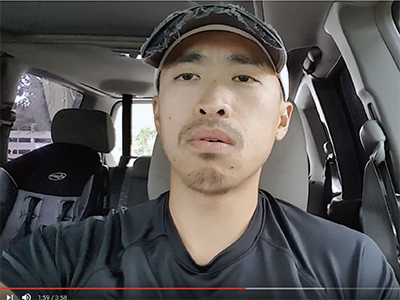
Calvin Yang’s social media following began after he took out his phone and filmed his first video in his car after one of his doctoral classes at Saint Mary’s in August 2017. The topic of his first video focused around the meaning behind a Hmong proverb that translates into English as, “Take a wrong step, and you can take that step back. Misspeak, and you won’t be able to take those words back.”
Yang, who is Hmong, immediately envisioned talking to an older Hmong individual from his community. He also thought about some of the Hmong proverbs shared with him by his family members — and how many of them were cloaked with confusion in his mind. He imagined others in the local Hmong community must have the same lack of clarity, especially within the context of trying to assimilate to modern-day life in the U.S.
“I was thinking, ‘This is something I have struggled with my whole life. And if I’m a practitioner and I don’t understand this, how am I going to be able to work with my own population?,’” said Yang, who is projected to finish his doctorate in 2021. “I thought, ‘Why don’t I share this with the people who I know in my community, so that if they’re struggling with similar issues, they can also use this to help them understand their culture and language better?’”
Yang sat down his car, hit record on his cell phone, and began talking about the first of what would become many proverbs. He posted the video to Facebook for family and friends, only to see an explosion of notifications. Immediately, his followers requested that he change the videos from private to public, so that they could share with others. They left a long line of reactions and comments.
Shortly after his Facebook account took off, Yang established a YouTube channel under the name of “dictum dose,” as another avenue to spread his videos (in December, he launched a website of the same name, which includes all of his video content and merchandise). On the wings of his videos’ popularity, Yang received an invitation to speak at an event called Culture Core at the University of Wisconsin-Eau Claire in March 2019.
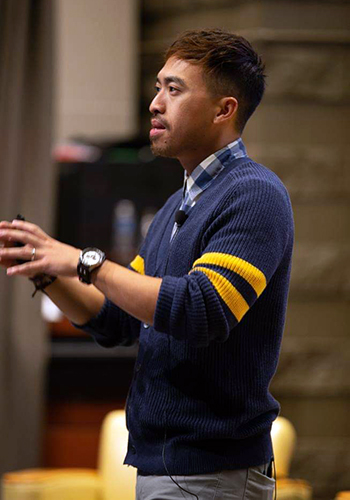
While working on his doctoral degree, Calvin Yang M’17 has done several large speaking engagements — including talks at conferences last year at St. Catherine’s University and the University of Wisconsin-Eau Claire.
Later in October, he served as the keynote speaker at the 5th Hmong Studies Consortium International Conference at St. Catherine’s University. His speech for both occasions focused on the challenges that come with navigating two different cultures, particularly as Hmong children born in the U.S. He points out that according to a 2017 study, Minnesota has the second largest Hmong community next to California. Wisconsin is third.
Although Yang had not done a lot of speeches in front of large audiences, nerves did not get to him.
“I felt comfortable because the content that I’m sharing comes from a place that I’ve wrestled with my entire life,” he said. “The things I share with people also help them find answers to the questions they’ve been having about juggling these two identities.”
When not talking at conferences, Yang can be found at local schools in the Twin Cities area talking to Hmong students about mental health issues as a committee member of a grassroots movement known as “Project Sunshine.” It formed as a means to spread awareness about mental health after a Hmong student committed suicide this past summer in Brooklyn Park, Minn. Yang said, in general, mental health has never been culturally or socially accepted by the Hmong community.
‘People are not tight’
Yang moved to Saint Paul in 1996 as a response to growing gang violence in his native Fresno, Calif. His family — including his father, mother, and six siblings — would move into a duplex shared with several of his uncles and their families, creating upwards of 20 people under one roof for about two years. Such an arrangement conjured up one famous Hmong proverb that when translated to English says: “The house is tight, but people are not tight.”
“The underlying message with that is that the house may be filled with 20, 30, 40 people, and we may be shoulder to shoulder. But we, as people, have a very open heart,” Yang says. “We’re welcoming and it never feels tight to us.”

alvin Yang M’17 and his wife, Zong (M’11), pose with their four children while wearing traditional Hmong clothing.
After graduating from the University of Minnesota with a degree in psychology, Yang wanted to pursue the field in greater depth, but those plans were halted after he and his wife married and began having children. They have two boys and two girls. “She was actually my very first best friend,” Yang said of his wife, whom he met in sixth grade at Hazel Park Academy in Saint Paul.
To provide for his family, Yang took a job as an insurance adjudicator, a position he held for five years. In that job, part of his responsibilities was working on mental health-related claims, allowing him to see firsthand the issues that he had studied as an undergraduate.
His wife, Zong, having earned a M.A. in Human Resource Management at Saint Mary’s in 2011, encouraged him to check out the M.A. in Counseling and Psychological Services program.
“I looked at Saint Mary’s and it was affordable and it was very flexible,” Yang said of starting the master’s program in 2014. “It was catered toward young, working adults. And so I thought, ‘Hey, why not? If I can do this and still be a parent, I’ll do it.’”
A seminal moment
The decision to pursue his Psy.D. was solidified in large part by one conversation that he had in 2016 with his oldest child, who was in kindergarten at the time: A fellow student told her that she could not play with them on that day “because brown people can’t play with us.” His daughter wanted to know what that meant.
“I wasn’t sure how to explain it to her,” Yang said. “So of course, I just told her, ‘Kids will be kids, and they just don’t want to play with you and that’s OK. No big deal.’ But inside something was boiling up like, ‘What does this mean to me? What am I going to do about this?’”
Yang realized that he did not possess the language to articulate what he wanted to say to his daughter in a way that both she could completely understand and that would satisfy him.
“I think the program at Saint Mary’s really gave me that language. I think the biggest piece I learned was to be OK with feeling upset that I was discriminated against. I’m able to have a voice.”
— Calvin Yang
“I think the program at Saint Mary’s really gave me that language,” Yang said, by helping him step outside of his comfort zone and develop greater self-awareness and understanding. He points in particular to conversations he has had at the monthly university-affiliated Student of Color Consultation meetings held at the Twin Cities Campus.
“I think the biggest piece I learned was to be OK with feeling upset that I was discriminated against. Before, I’d think, ‘OK, it’s not a big deal. Move on,’ but now, it’s ‘No, that’s not OK. And what happened there is also not OK.’ I’m able to have a voice,” Yang said when reflecting upon his own experiences that he had swept under the rug, so to speak, while growing up.
“I think the faculty of Saint Mary’s has helped me to understand more about the impact that I have on my kids and how my culture in itself impacts my life overall.”
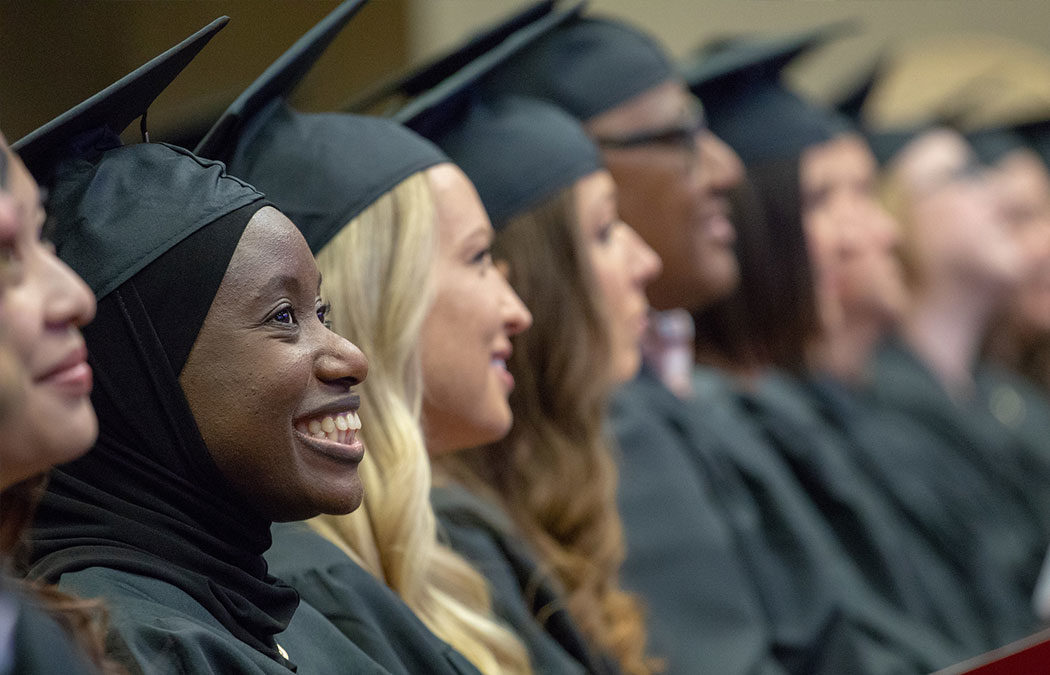
Adult learners to graduate Jan. 25 on Saint Mary’s Twin Cities Campus
MINNEAPOLIS, Minn. — More than 370 adult learners will graduate from Saint Mary’s University of Minnesota and its Schools of Graduate and Professional Programs on Saturday, Jan. 25, where two commencement convocations will honor the graduates.
The ceremonies, to be held at 10 a.m. and 12:30 p.m. at the Saint Mary’s University Center on Park Avenue in Minneapolis, will feature four graduates who have been invited to provide reflections as part of the ceremonies. Another five graduating students will be honored with awards.
Graduating students providing reflections are:
- Isse Abdi, B.S. in Information Technology
- Justin David Bloch, B.S. in Business Administration
- Jim Lee, M.A. in Educational Leadership
- Diana-Christine Teodorescu, Ed.D. in Leadership
Graduating students being honored with Outstanding Final Paper Awards are:
- DeVonne Rita Ollila-Sheak, B.S. in Marketing
- Shruti Jalota, M.A. in Management
- Nicolle Marie Venneman-Bauer, M.A. in English as a Second Language
- Amanda Mae Shultz, M.A. in Special Education
Graduating student being honored with Outstanding Dissertation Award is:
- Abdiqani Farah, Ed.D. in Leadership
Saint Mary’s Twin Cities Campus, Apple Valley location to close from 5 p.m. Friday through Saturday
Due to weather conditions, Saint Mary’s University’s Twin Cities Campus and Apple Valley location will close, beginning at 5 p.m. today, Friday, Jan. 17, and will remain closed Saturday, Jan. 18. No classes will be held in these two locations during this time, and offices will also be closed.
Three Doctoral Chevrons
There is a narrative from medieval times that describes the nature of the three chevrons on the sleeve of a doctoral robe. As legend has it, those three stripes stand for the three pillars of doctoral scholarship: academic curiosity, academic honesty, and academic courage. Whether or not this tale came from the hallowed halls of Oxford or not doesn’t really matter; what does matter is how we as scholars today support these pillars.
Academic curiosity means our minds are open, probing, and dynamically asking questions and seeking new perspectives of understanding. We show this in class by forming community, respecting the opinions of others, and engaging in critical dialogue without criticizing the character or humanity of another. We show this in our research through a disciplined and open approach, through a dedication to scholarly writing, and through a willingness to put theory to practice.
Academic honesty means a significant and holistic commitment to scholarship. We show this through our deep commitment to the rigorous coursework, comprehensive examination, and dissertation process. Being in attendance, with your whole self, not only benefits your scholarship, but the development of all those in your learning community. This is also shown through a significant attention to the practice of scholarship, both in the written and oral traditions. The integrity of your word — written, spoken, and practiced — is paramount.
Academic courage is displayed through the intention, attention, and dedication to ask hard questions, to work the data as it is, to report reality as it is experienced. We show this in class by not avoiding uncomfortable academic topics, or difficult conversations. As a Lasallian community of scholars and faculty, we care for the holistic development of all those in our cohort, and to the best of our ability we encourage and support their academic success.
By: Matthew Nowakowski, MBA, Ed.D., program director and core associate professor
The Value of Collaboration
There are many things that cannot be taught, and others that cannot be learned. Creativity, raw talent, ideation, and stakeholder theory are all problematic. Being in the DBA program requires a significant amount of time spent learning — venturing on an endless path of curiosity.
That said, it is not prudent to exclusively learn in isolation. Collaborating, cooperating, co-authoring, research teams, and writing partnerships should be part of your aspirations to support intellectual inquiry and cognitive development while at Saint Mary’s University of Minnesota… and beyond. This will help activate your creativity, talent, and ideation, and become intellectually awake.
I encourage you to take advantage of opportunities to work with members of your cohort, and faculty, and become active in management academic and practitioner professional organizations. Attend conferences. Conferences provide you with the opportunity to engage with other scholars, disseminate your work, think creatively about your learning, and have some fun with like-minded, like-experienced academics.
If you have questions about how to find conferences, develop writing proposals, or present your work, please don’t hesitate to contact me (or other DBA faculty members).
In creative, talented, idea association, Jennifer L. Schultz, PhD. jlschult@smumn.edu
By: Jennifer Schultz, Ph.D., core associate professor
A Transformational Experience
As you journey through this DBA learning experience, it is my hope that you are prepared for a transformational experience. The DBA experience is designed to be different from other educational experiences. It is more integrated and holistic in perspective. You can certainly ease your way through the program. However, if you challenge yourself cognitively and emotionally, your capacities will be stretched and strengthened.
The DBA experience should expose you to opportunities that change the way in which you see and interact with the world. For some, this may seem threatening. For others, it may seem too lofty, and for others this is why you enrolled in the program.
Earning a DBA is serious business. Maximum value can only be achieved when you commit the time and effort needed to fully leverage what is being asked of you. Hopefully, the whole experience will be transformative. If it wasn’t, then there is no valid reason for undertaking the experience. Since transformation is the goal, so it is prudent to clearly identify the goals to be attained.
After you have completed the program, how will you be different? Will you have to tell people you have obtained a DBA or will they know it through your insight and contribution? For example, a caterpillar doesn’t have to tell anyone it has become a butterfly. Similarly with you, people should see the difference. You need to set audacious goals. Accompanying these goals should be a plan for execution.
Some of these goals could include:
- heightened self awareness
- increased emotional intelligence/resilience
- strengthened level of confidence
- tolerance for ambiguity
- improved learning agility
- enhanced technical skills
- widened peer networks
A helpful way in seeing yourself differently is to think of yourself as a brand. Generally, we associate brands with corporations such as Nike, Starbucks, Apple, Southwest Airlines, etc. Over the years these brands have become powerful and they resonate emotionally with many people. The reason for the resonation is brands are relationships. There is an emotional connection. Brands stand for something. Brands are promises. Brands are distinctive. Brands are perceptions. Brands are relevant and they consistently deliver on their promise. Strong brands make a difference. The strength of a brand impacts the difference it is going to make. Companies that have a strong brand have a mission, vision, and values that are shared by associates and clients. Strong brands are game changers.
The concepts of being a brand and making a difference have been adopted by many individuals who have branded themselves. Strong individual brands that quickly surface are George Foreman, Tiger Woods, Kylie Jenner, Kim Kardashian, Will Smith, Rihanna, Julia Roberts, David Beckham, and Oprah Winfrey. Over the years, these individuals spent time developing their brands. They also know how to leverage their brands. Recently, Kylie sold part of her brand name company for over $600 million.
As you begin your transformational experience, I encourage you to craft your life’s mission, vision, and values. By developing these, you create the possibility of greatness. As you strengthen these, they will resonate with others and increase your effectiveness.
Brands are about making a difference. The question is, “Are you prepared to make a difference?”
Reference Books
The Art of Possibility: Transforming Professional and Personal Life by Rosamund Stone Zander, and Benjamin Zander
Free Agent Nation: The Future of Working for Yourself by Daniel H. Pink
The Brand You 50: Or: Fifty Ways to Transform Yourself from an ‘Employee’ into a Brand That Shouts Distinction, Commitment, and Passion! by Tom Peters
The Brand Called You. Forget about Your resume. You don’t have a Resume. You’ve got a Marketing Brochure for the Brand Called You. Fast Company. by Tom Peters.
Be Your Own Brand: A Breakthrough Formula for Standing Out from the Crowd by David McNally and Karl Speak
Build Your Own Life Brand! : A Powerful Strategy to Maximize Your Potential and Enhance Your Value for Ultimate Achievement by Stedman Graham
Make a Name for Yourself: Eight Steps Every Woman Needs to Create a Personal Brand Strategy for Success by Robin Fisher Roffer
The Product Is You!: Position Yourself for Success as an Advisor by Mark Magnacca
By: Brian (Raj) Beekie, M.A., Ed.D., core associate professor
